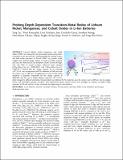Notice
This is not the latest version of this item. The latest version can be found at:https://dspace.mit.edu/handle/1721.1/139772.2
Probing Depth-Dependent Transition-Metal Redox of Lithium Nickel, Manganese, and Cobalt Oxides in Li-Ion Batteries
| dc.contributor.author | Yu, Yang | |
| dc.contributor.author | Karayaylali, Pinar | |
| dc.contributor.author | Giordano, Livia | |
| dc.contributor.author | Corchado-García, Juan | |
| dc.contributor.author | Hwang, Jonathan | |
| dc.contributor.author | Sokaras, Dimosthenis | |
| dc.contributor.author | Maglia, Filippo | |
| dc.contributor.author | Jung, Roland | |
| dc.contributor.author | Gittleson, Forrest S | |
| dc.contributor.author | Shao-Horn, Yang | |
| dc.date.accessioned | 2022-01-27T15:41:46Z | |
| dc.date.available | 2022-01-27T15:41:46Z | |
| dc.date.issued | 2020 | |
| dc.identifier.uri | https://hdl.handle.net/1721.1/139772 | |
| dc.description.abstract | © 2020 American Chemical Society. Layered lithium nickel, manganese, and cobalt oxides (NMC) are among the most promising commercial positive electrodes in the past decades. Understanding the detailed surface and bulk redox processes of Ni-rich NMC can provide useful insights into material design options to boost reversible capacity and cycle life. Both hard X-ray absorption (XAS) of metal K-edges and soft XAS of metal L-edges collected from charged LiNi0.6Mn0.2Co0.2O2 (NMC622) and LiNi0.8Mn0.1Co0.1O2 (NMC811) showed that the charge capacity up to removing ∼0.7 Li/f.u. was accompanied with Ni oxidation in bulk and near the surface (up to 100 nm). Of significance to note is that nickel oxidation is primarily responsible for the charge capacity of NMC622 and 811 up to similar lithium removal (∼0.7 Li/f.u.) albeit charged to different potentials, beyond which was followed by Ni reduction near the surface (up to 100 nm) due to oxygen release and electrolyte parasitic reactions. This observation points toward several new strategies to enhance reversible redox capacities of Ni-rich and/or Co-free electrodes for high-energy Li-ion batteries. | en_US |
| dc.language.iso | en | |
| dc.publisher | American Chemical Society (ACS) | en_US |
| dc.relation.isversionof | 10.1021/ACSAMI.0C16285 | en_US |
| dc.rights | Creative Commons Attribution-Noncommercial-Share Alike | en_US |
| dc.rights.uri | http://creativecommons.org/licenses/by-nc-sa/4.0/ | en_US |
| dc.source | DOE repository | en_US |
| dc.title | Probing Depth-Dependent Transition-Metal Redox of Lithium Nickel, Manganese, and Cobalt Oxides in Li-Ion Batteries | en_US |
| dc.type | Article | en_US |
| dc.identifier.citation | Yu, Yang, Karayaylali, Pinar, Giordano, Livia, Corchado-García, Juan, Hwang, Jonathan et al. 2020. "Probing Depth-Dependent Transition-Metal Redox of Lithium Nickel, Manganese, and Cobalt Oxides in Li-Ion Batteries." ACS Applied Materials & Interfaces, 12 (50). | |
| dc.relation.journal | ACS Applied Materials & Interfaces | en_US |
| dc.eprint.version | Author's final manuscript | en_US |
| dc.type.uri | http://purl.org/eprint/type/JournalArticle | en_US |
| eprint.status | http://purl.org/eprint/status/PeerReviewed | en_US |
| dc.date.updated | 2022-01-27T15:37:17Z | |
| dspace.orderedauthors | Yu, Y; Karayaylali, P; Giordano, L; Corchado-García, J; Hwang, J; Sokaras, D; Maglia, F; Jung, R; Gittleson, FS; Shao-Horn, Y | en_US |
| dspace.date.submission | 2022-01-27T15:37:22Z | |
| mit.journal.volume | 12 | en_US |
| mit.journal.issue | 50 | en_US |
| mit.license | OPEN_ACCESS_POLICY | |
| mit.metadata.status | Authority Work and Publication Information Needed | en_US |
